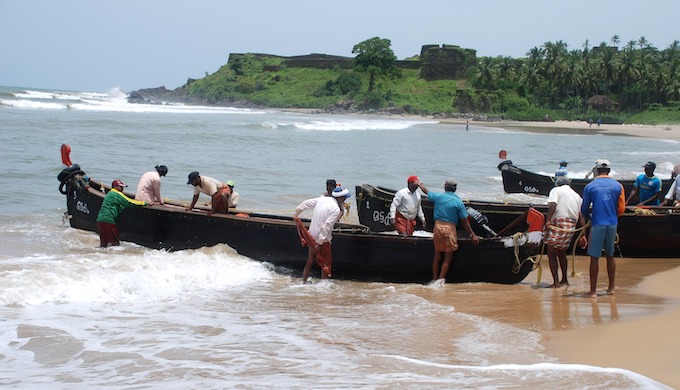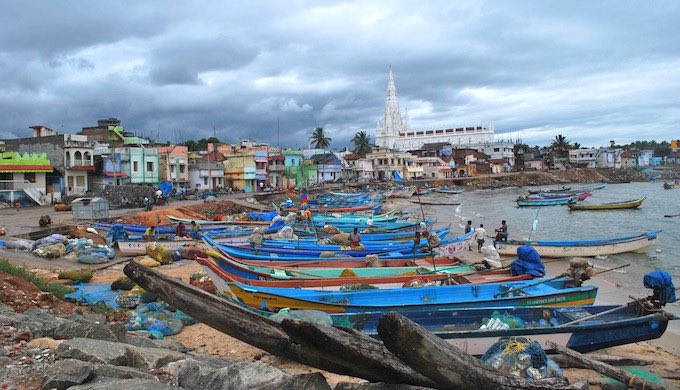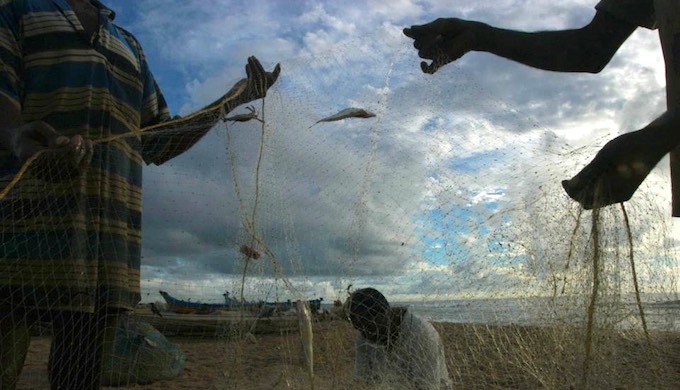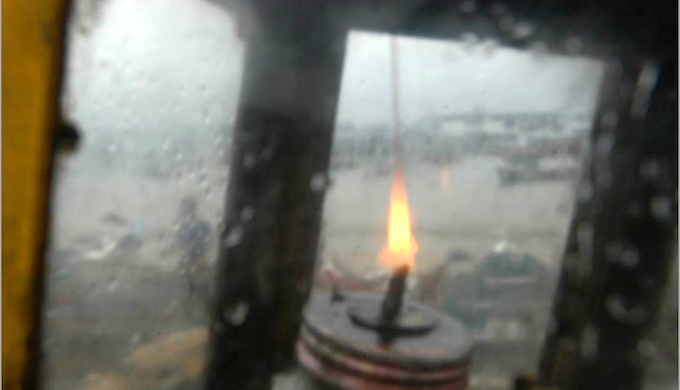The lack of a well-coordinated and effective early warning system for cyclones often catches fishers on the Kerala coast unawares, especially when the electronic media is apathetic about broadcasting it, as the scores of deaths in high seas during Cyclone Ockhi proved yet again

Cyclone season in Kerala would be less hazardous to fishers if they were adequately forewarned (Photo by Frank Raj)
Soosai Melkias spent the first days of December repairing his house damaged by Cyclone Ockhi. Every monsoon, angry waves carve out parts of his village, Anchuthengu, a thin green strip between the Arabian Sea and a lagoon 36 km north of state capital Thiruvananthapuram.
This time the damage was worse.
Still, Melkias is grateful.
He survived the storm.
Melkias, a fisher in his mid-30s, had gone to his family home in Poonthura, a coastal village at the other end of the Parvathi Puthanar canal that starts near his village. That was November 29, a day before cyclone warnings were issued over loudspeakers back home. Nobody told him there was going to be a storm.
“We heard there was good fish catch in Poonthura and my brother advised me to stay back and go fishing.” Melkias and three colleagues launched their boat, a 32-foot fibreglass vessel powered by two nine horsepower Suzuki outboard engines. It is considered an efficient configuration that allows a speed of 25 km an hour (kmph).
At about 3.30 pm, the crew took the boat south of Poonthura, about 42 km off Kovalam beach, a famous tourist spot. About 100 boats would have gone fishing that day from Poonthura area.

Kanyakumari on the southern tip of India suffered extensive damage due to Cyclone Ockhi (Photo by Ankyuk)
The same day, India Meteorological Department (IMD) had issued a bulletin at 11.50 am and sent it to top officials, including director generals of All India Radio and Doordarshan. It had an advisory for fishers not to go to the sea as squally winds reaching 45-55 kmph gusting to 65 kmph were likely along the coast of southern Kerala.
The fishers did not know. The media largely missed it too.
Two other bulletins followed. The officials later said they dismissed them as a routine warning.
The State Disaster Management Authority sent a message to its contacts over WhatsApp at 4.01 pm on November 29: “Sea conditions would be rough to very rough along & off South Tamil Nadu and South Kerala during the next 48 hours…”
Still not many subscribers in the media paid any heed. A few newspapers carried the item the following day. Radio and television stations ignored it. Much of the damage was on November 29.
Earlier, in the beginning of the monsoon season, when the sea is very rough and fishers face accidents in the sea, SDMA had invited FM radio representatives and advised them to take marine forecasts seriously, as a service to fishers. Some of the stations listened. There was an interview with a fisherman on air.
The enthusiasm waned soon.
In the dark
On the evening on November 29 at 5 pm, the IMD and the Indian National Centre for Ocean Information Services (INCOIS) issued a joint warning: “High waves in the range of 3.0 – 4.2 metres are forecasted during 17:30 hours on 29-11-2017 to 23:30 hours of 01-12-2017 along the coast of Kerala from Vizhinjam to Kasaragod. Current speeds vary between 47 – 65 cm/sec.” This advisory also warned of “squally winds” reaching 45-55 kmph gusting to 65 kmph and rough to very rough sea conditions and advised fishers not to venture into the sea.
In simple terms, squally means a condition with sudden, sharp increases in wind speed, and gusting denotes wind speeds that keep shooting up.
Still, surprisingly, this advisory did not become part of any widely disseminated text message service. Three-metre waves — and 55 kmph wind — can capsize a small boat, throw the crew overboard, or even crash the vessel.
Still, nobody acted.
A single word — cyclone — in the alert would have made a world of difference, officials insist.
Officially, the government machinery starts grinding at full force only after a cyclone alert. That came only on N0vember 30 by noon, as officials have noted.
Inadequate early warning
Cyclone warning is an elaborate affair that should start 72 hours before the landfall of the cyclone. It involves four phases, and action at various levels. The messages include messaging at three-hour intervals giving the latest position of cyclone, its intensity, likely point and time of landfall, rainfall, strong wind and storm surge along with their impact and advice – to the media, fishers, disaster managers and general public. That meant action – blaring loudspeakers on the coast, deploying rescue personnel on alert, evacuating low-lying coasts and so on.
Till November 29, IMD called the weather system a deep depression, a term used in Bangladesh, India and Pakistan for 51 to 61 kmph wind. At 62 kmph, the system becomes a cyclone, and at 119 kmph, a very severe cyclone, as Ockhi eventually became.
Amidst this semantic and procedural confusion and sheer inaction, Melkias and colleagues received no warning.
India’s weather and disaster alert systems are largely land-based, with little attention to the conditions that small boats face offshore. As such, out there 42 km offshore, beyond the range of mobile phones and FM radio, without very high frequency radio sets, small boats operate in the dark.
“At about 7.30pm, the wind became very strong,” Melkias told indiaclimatedialogue.net. “The anchor would not hold. The waves were about three or four metres high. They were not folding waves, but swell. We started our journey back at 8.45 pm, but in the rough sea we could not go on a straight line to the coast.”
The waves were probably even higher than three metres. Some local fishers claimed they faced waves the size of a two-storeyed building. “They have not seen such waves in their lives,” assistant parish priest of Poonthura, Deepak Anto, told indiaclimatedialogue.net. “Some said they were scared to go to fish again.”
Regular forecasts could have indicated trouble
In hindsight, Melkias says an early alert would have helped. “Had we known there would be high wind, we would not have gone. Even if some fishers had gone, when the weather turned bad, they could have come back to the shore immediately.”
INCOIS marine weather bulletin issued on November 28 had predicted 33 kmph wind for November 29, but the high wave alert came only on November 29.
There were indications of a moving, possibly strengthening storm. For about a week, messages of the Global Maritime Distress and Safety System (GMDSS), including through the IMD website, had talked about a weather system moving northward, with alerts on high waves.

Fishers mend nets before going to sea. This is when they look for weather forecasts (Photo by Gireesh GV)
GMDSS alerts are sent to ships and big boats over special equipment. Besides basic training is needed to interpret these messages. Small boat fishers do not get these messages. In Thiruvananthapuram, most fishers operate only small boats that have no radio communication equipment.
Missing the larger picture
Going by Melkias’s logic, an appreciation of the weather conditions with the large picture would have given some sense of foreboding to the fishers.
There is no system to give the fishers a clear and understandable interpretation of the impacts of a storm system that was passing by. Storms can change course and cover large areas.
Weather bulletin announcers as a matter of practice stay away from making their own interpretation of the weather systems they report on, and leave it to experts and officials for value addition. It is even illegal to give warning on one’s own.
Melkias survived the storm despite everything. “We normally cruise at around 10 miles (16 km) an hour, but we could not even attain a speed of three to four miles in the stormy sea,” he recalled to indiaclimatedialogue.net. “By about 2 am, with great difficulty, we reached the shore south of Poonthura.”
While Melkias and colleagues were struggling, reportedly there was some official communication happening on the shore. Fax messages were sent to the chief secretary’s office, detailing the direction of the wind, as it was reported. There were phone calls too. Information on the IMD website suggests that a series of fax messages were sent to top officials, including Directors General of All India Radio and Doordarshan.
About 50 boats reached Poonthura by 2 am on November 30, and some landed on the shores of other villages.
Some never did.
Poonthura was one of the worst affected villages in the cyclone. Many people went missing in the sea. Information collected by December 8 showed that 29 people went missing from the village, said Anto, citing a survey done by the Centre for Fisheries Studies. On December 5, the Home Ministry stated that 69 people had died and 167 fishermen were missing after the cyclone hit Kerala and Tamil Nadu. The Armed Forces have rescued over 200 people.
Mixed messages
The fishers are angry. There is tension along the coast, marked by roadblocks, protest marches, and verbal abuse of political leaders who visit coastal villages.
In fact, there were messages. They were not loud and clear. And the fishers largely had no access to them. Even those with access to routine messages, could not figure out the difference between routine forecasts and specific event warnings.
On one level, IMD has been frequently issuing warnings about 45-55 km per hour wind throughout the monsoon season. They also ask fishers to be alert, or avoid going to fish at times. As Kerala chief secretary K.M. Abraham reportedly said, these alerts and advisory to fishers not to venture into the sea were quite frequent during this season, and hence IMD warning issued the day before the cyclone was communicated through usual modes like media. Even that was not effective — few outlets carried the news.
Fishers in Thiruvananthapuram used to take the wind advisories as a joke. “They say 55 kmph wind, and it does not happen,” Thampi, a fisherman in Puthukurichy, a village near Anchuthengu, told indiaclimatedialogue.net. “They also say it might or might not rain. How can one listen to such forecast?”
Officials point out that even the forecast on December 7, much after the cyclone, noted: “Strong winds from northerly direction, speed occasionally reaching 45-55 kmph likely along & off Karnataka Kerala coasts and Lakshadweep area.” At Puthukurichy, the local community members blared it over a loudspeaker, the announcer even called back fishers who had gone to fish.
“They now want to have their own alert system,” said Aloysius Gomez, a retired science teacher from the village, who has been advocating a weather forecast communication system along the coast. “The community does not trust officials any more.”

A calm night on the sea shore. Landing and launching boats at night involve added risks (Photo by Gireesh GV)
IMD Thiruvananthapuram director S. Sudevan explained that IMD has to issue alerts when there are winds of 40 kmph and above. There could be jets of wind occasionally reaching this speed. Jet streams or fast, narrow, meandering air currents in the atmosphere are associated with monsoon rains, and within the jet stream there could be very fast local streaks. Such sudden bursts of winds can catch boats off guard.
“We are not really worried about such short spells of wind,” Melkias said. “We know they go away in a while, or after a rain.” What worries the fishers is wind of sustained high speed.
Being forewarned
Back in Anchuthengu, Melkias’s friends said if they have information about unusual wind patterns, they limit their fishing to the coastal waters. “We don’t know what is out there offshore. There is no way we can see that,” said Jerome, a middle-aged fisherman at Anchuthengu. Some veteran fishers called Chelalis make assessment about such wind. “Then they say leave the sea, and we listen,” Melkias said.
That is the usual practice followed by the fishers — making some informed guesses, even while always taking calculated risks. As it happens there was no casualty or boat missing from Anchuthengu and villages nearby.
Fishers tend to take their decision on what scientists call bounded rationality, or making decisions within the limits of information available, capacity to process it and the time available.
Lack of systems
The problem is that there is little information on marine weather readily available for the fishers. “Obviously, there are no effective systems in place to respond to such emergencies, and no way of warning fishermen,” noted former Prasar Bharati official and one of the early advocates for community radio stations in the country, Sajan Venniyoor. “Thirteen years after the tsunami, we are not even close to setting up an effective warning system for the coast.”
Venniyoor questioned the way IMD protocol of sending faxes to top officials about the disaster, even out of office hours, without disseminating information locally: “Since I have worked in both AIR and Doordarshan, I can assure the Met Department that not only are the fax machines in the DG’s office not manned at 8.30 am, by the time it is put up on file and sent somewhere for action, the storm would have long blown over.”
“I’m surprised they didn’t use carrier pigeons,” Venniyoor joked.
Risk communication problem is more systemic and all pervasive. Marine weather forecast is not routinely given over the radio or television. Weather forecasts — including the damage predicted due to cyclones — are largely land-based. Even in the IMD advisories issued the indications given are trees and lamppost falling. Not what the sea would look like, or what could happen to a small boat in 65 km wind and three metre waves. They do not stand a chance under such conditions. Experts suggest simplified communication tools such as the Beaufort Scale to let the fishers understand the seriousness of such situations.
Fishers often miss television news. “Many of us don’t really watch television, and sometimes compete for television with the family keen on listening to music or serials,” Melkias told indiaclimatedialogue.net. “On week days we go fishing for 10 to 12 hours, sleep, eat, mend nets and then go fish again,” said a young fisherman in Poonthura. “There is no free time.”
Fishers do not usually carry radio either. “They get wet. It would be nice to listen to some songs out there though,” said a young fisherman in Poonthura.
Technologies that work
A gadget that almost all fishers carry is a mobile phone, usually wrapped in a transparent plastic sheet. “We often use mobile phones to pass information about wind and waves,” said the young fisherman of Poonthura.
It is a kind of local, private social network to pass information on fishing grounds, safe routes and position of colleagues. “If we find fish at a coordinate we mark in on our GPS (Geographical Positioning System) and tell our friends. We also warn them about dangerous spots, like the pier in Anchuthengu (where several boats have crashed).

Mechanised fishing vessels have better safety features, unlike open small boats (Photo by Gireesh GV)
INCOIS now has a free text message facility for fishers. If fishers register their phone number with the agency they can get daily messages on fish availability, weather and sea state (wind, waves, currents), besides safety alerts. INCOIS or the state government, however, does not have a system to collect and pass on text messages. Fishers, on their part, prefer voice messages to text. “Call us; give calls like those from the Prime Minister’s Office,” said a fisherman in Poonthura.
However, officials said such calls are very expensive on a massive scale. Still INCOIS officials said they would explore the possibility of using voice short messaging service (SMS) that is comparatively cheaper.
INCOIS and the Chennai-based M S Swaminathan Research Foundation tried to popularise smart mobile phones with a special application to receive marine weather alerts and information on fishing zones. Somehow representatives of traditional fishers in Thiruvananthapuram largely rejected them, one reason being the concern that trawlers would monopolise the fishing grounds. Smart phones are not very popular on board small boats – they are expensive, and get spoilt.
Even with mobile phones there would be the issue of last mile reach. For the fishers offshore, mobile alerts can work only up to 20 km or so into the sea. Fishers of Poonthura often go about 50 km off the coast of Anchuthengu, Varkala further north. Then mobiles are of not of much use. In Poonthura, young fishers use VHF, even in small boats. They have a sort of private information sharing network over VHF too. “If we have a harbour-based weather alert system over VHF that can be very useful. We can know what is going on.”
INCOIS officials have noted that they are considering a system that can provide sea state information over VHF radio to fishers. Navtex (Navigational Telex) is another international automated medium frequency direct-printing service that delivers navigational and weather alerts and forecasts to ships, including GMDSS service.
Thiruvananthapuram IMD office, on its part, has assured better contacts with the media in future, and training for fishers. “We can provide information of marine weather from coastal weather radars and GMDSS. The fishers need training in accessing and interpreting this information. We can train them as well, so long as someone takes care of these programmes,” Sudevan said.
Back to basics
Even amidst all these challenges and high-tech options, what Melkias and colleagues ask for is something very low tech and inexpensive: A loudspeaker at the harbour with regular reliable forecasts. “We can listen when we launch our boat or prepare for the following. If we are away, those who listen can tell us what the sea is like,” said Jerome.

The coast near Kovalam is one of the crowded small-boat fishing spots in the region (Photo by Syam)
At Poonthura, Anto, who is trained as a journalist, said even loudspeakers at places of worship could be effectively used to issue warning. Most of the 44 fishing villages in Thiruvananthapuram have places of worship, mostly churches with a few mosques and temples, equipped with loudspeakers.
At Anchuthengu people did not venture into the sea on November 29. Melkias suspects it was only due to lack of fish there. Possibly it was fear of the sea too, with Anchuthengu having witnessed several accidents in the sea this monsoon season.
Still fishers of the area proved to be brave enough to cut through the waves to save a colleague from southern Thiruvananthapuram, who was spotted in the sea on his small craft that drifted there on December 1.
Midway, at about 8.30 am, the man was seen on the coast of St Andrews. In pouring rain and high wind, a crowd gathered, helplessly watching him go by as a dot across all those waves, nobody daring to launch a boat. A lone policeman was seen frantically making some calls, narrated Xavier Napoleon, a local resident. Napoleon witnessed the unfolding drama for a while, before leaving in sheer frustration. “I could not stand the sight anymore,” he told indiaclimatedialogue.net.
Further north, somebody saved the man a few hours later. “Some fishers bravely launched their boat, the man left his boat and swam and the fishers saved him,” said Gomez.
Melkias said it was fishers from his neighbouring village Mampally who saved the man. “Train a small group of fishers in every village — we can help the rescuers, we know the sea.” Anchuthengu already has a disaster management committee trying to make the local harbour safer.
Now SDMA has a plan to launch a comprehensive risk communication system on the coast as part of a national cyclone response initiative. INCOIS has been trying to introduce a multi-channel, multi-media marine weather advisory system for a long time. Fishers’ organisations and support groups are keen to have their own community radio. Churches may give weather reports over their loudspeakers.
Melkias offers a lesson to all of them: Listen to the fishers.

Trackbacks/Pingbacks